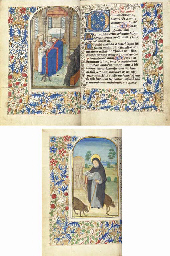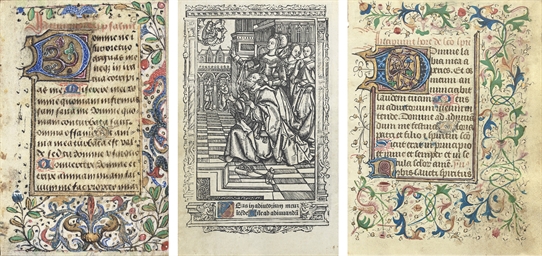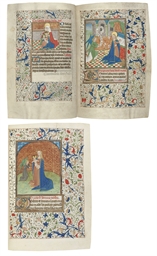Book of Hours in Dutch
illuminated manuscript on vellum. [Netherlands (South Holland), 15th century (last quarter), with additions datable to c.1481]
155 leaves, c.165×110mm, with no flyleaves but apparently COMPLETE, collation: 112, 2–78; 8–138; 14–188, 198-1 (final blank cancelled); traces of catchwords survive sporadically; ruled in ink for 19 lines per page, the ruled space c.106×67mm; written in a fine gothic script; decorated with ONE FULL-PAGE MINIATURE SURROUNDED BY A FULL BORDER from (or intended for) a much smaller volume with an added full border, THREE 8-LINE INITIALS ACCOMPANIED BY A FULL BORDER, SIX 5-LINE INITIALS IN GOLD WITH BLUE PENWORK, one 4-line initial in blue with red penwork for Lauds, 2-line initials throughout alternately blue with red penwork, or vice versa, 1-line initials alternately plain red or blue (minor blemishes throughout, but overall in fine condition). SEWN ON FIVE BANDS AND BOUND IN CONTEMPORARY POLISHED BROWN LEATHER OVER WOOD BOARDS, each cover blind-tooled with a lattice pattern, the interstices with flower motif and fleurs-de-lys, the edges of the leaves gilt (the two clasps missing, the upper joint broken).
PROVENANCE
1. Aeltgen, daughter or widow of Jan Bochs: the end of the original text is followed by an added ownership inscription: ‘Dit boeck hoert toe Aeltgen Jan Bochs. Diet vyndt brenct det weder om die minne gods’ (f. 153v); several pages originally left unwritten have added prayers apparently by the same scribe, including those immediately after the calendar, with the date 1481.2. Maria Spruijt, late 15th/16th century (inscription, upper pastedown); she may have been responsible for several additions to the calendar.3. Mary Willett, of ‘Cudwells’, Lindfield, East Sussex (late 19th-century inscription, upper pastedown).4. Hodgson & Co., London, Catalogue of Rare & Valuable Books, Manuscripts and Bindings, 29 March 1906, lot 182.5. J. & J. Leighton, London, Catalogue of Manuscripts Mostly Illuminated, Many in Fine Bindings (1912), no. 149.6. Reginald Cecil Powys-Lybbe (1881–1930), of Thurle Grange, Streatley, Berkshire (inscription, upper pastedown).7.Sotheby’s, 11 July 1960, lot 159; bought by a friend of the present owner, to whom it was given.
TEXT
1. (ff. 1r–11r) Calendar, with the seven feasts indicative of the diocese of Utrecht, all in red: Pontianus (14 January), Pancratius (12 May), Odulf (12 June), Lebuin (25 June and 12 November), the translation of Martin (4 July); and Willibrord (7 November); St Augustine (28 August) is in plain black.2. (ff. 11r–12v) Five added prayers, ‘Dit is die .v. collect op den paesch’; notes relating to Easter, dated 1481 (reproduced in the 1912 Leighton catalogue, see Provenance); a rubric introducing the Hours, ‘Hier beghint onser liever vrouwen ghetide in duutsche’; and further prayers.3. (ff. 13r–60r) Hours of the Virgin, with Matins (f. 13r), Lauds (f. 22r), Terce (f. 35r), Sext (f. 38r), None (f. 41v), Vespers (f. 44v), and Compline (f. 51r).4. (ff. 61r–76v) The Seven Penitential Psalms (with rubric on f. 60r, ‘Hier beghinnen die seven psalmen van penitencien in duutse’), followed (f. 71v) by a litany of saints in which Augustine is first among the confessors; and collects.5. (ff. 77r–108r) Prayers, including ones on the Seven Last Words, to the Virgin, to one’s guardian angel, to numerous saints, and at Mass.6. (ff. 109r–153v) Office of the Dead, with rubric on f. 108r, ‘Hier beghint die langhe veghelie in duutsche mit neghen lessen’.7. (ff. 153v–155v) Added ownership inscription (see Provenance) and prayers.
ILLUMINATION
Each of the major texts is introduced by a large illuminated initial and full border (ff. 13r, 61r, 109r), and each begins a new quire. The illumination can be attributed to South Holland (Zuid-Holland), i.e. the area between Rotterdam, Leiden, and Gouda. The main evidence is the presence of St Jeroen on 17 August in red in the calendar: he was venerated in a wide area around Noordwijk, on the North Sea coast near Leiden, where his relics were found, and is almost always entered in red in manuscripts produced in Leiden (see Anne Korteweg, ‘Books of Hours from the Northern Netherlands Reconsidered: the Uses of Utrecht and Windesheim and Geert Grote's Role as a Translator’, in Books of Hours Reconsidered, ed. by S. Hindman and J.H. Marrow (London, 2013), pp. 233–59 at 238). Secondly, the pen-flourishing uses motifs known as ‘radishes’ and ‘aubergines’ and is a wide-spread style in South Holland. In the painted decoration, the striking yellow bulbs that sprout from circular blue flowers can only be paralleled in manuscripts from South Holland in the last quarter of the century.
The final page of the middle section was originally left blank, to which was stuck a single-leaf miniature, with a gently arched top, surrounded by a full border of acanthus leaves and gold discs (f.108v); the miniature depicts a Funeral Service, with a hooded mourner sitting to one side of a bier draped in a blue cloth surrounded by lighted talers, and two clerics performing the service. The miniature appears to be Flemish of about the mid-century, and thus was probably extracted from an older Book of Hours, or it may have existed as a loose sheet.
BIBLIOGRAPHY
Unpublished apart from the auction and dealer catalogues cited under Provenance.
We are grateful to Anne Korteweg and Ed van der Vlist for their generous help with this manuscript.
Book of Hours in Dutch
illuminated manuscript on vellum. [Netherlands (South Holland), 15th century (last quarter), with additions datable to c.1481]
155 leaves, c.165×110mm, with no flyleaves but apparently COMPLETE, collation: 112, 2–78; 8–138; 14–188, 198-1 (final blank cancelled); traces of catchwords survive sporadically; ruled in ink for 19 lines per page, the ruled space c.106×67mm; written in a fine gothic script; decorated with ONE FULL-PAGE MINIATURE SURROUNDED BY A FULL BORDER from (or intended for) a much smaller volume with an added full border, THREE 8-LINE INITIALS ACCOMPANIED BY A FULL BORDER, SIX 5-LINE INITIALS IN GOLD WITH BLUE PENWORK, one 4-line initial in blue with red penwork for Lauds, 2-line initials throughout alternately blue with red penwork, or vice versa, 1-line initials alternately plain red or blue (minor blemishes throughout, but overall in fine condition). SEWN ON FIVE BANDS AND BOUND IN CONTEMPORARY POLISHED BROWN LEATHER OVER WOOD BOARDS, each cover blind-tooled with a lattice pattern, the interstices with flower motif and fleurs-de-lys, the edges of the leaves gilt (the two clasps missing, the upper joint broken).
PROVENANCE
1. Aeltgen, daughter or widow of Jan Bochs: the end of the original text is followed by an added ownership inscription: ‘Dit boeck hoert toe Aeltgen Jan Bochs. Diet vyndt brenct det weder om die minne gods’ (f. 153v); several pages originally left unwritten have added prayers apparently by the same scribe, including those immediately after the calendar, with the date 1481.2. Maria Spruijt, late 15th/16th century (inscription, upper pastedown); she may have been responsible for several additions to the calendar.3. Mary Willett, of ‘Cudwells’, Lindfield, East Sussex (late 19th-century inscription, upper pastedown).4. Hodgson & Co., London, Catalogue of Rare & Valuable Books, Manuscripts and Bindings, 29 March 1906, lot 182.5. J. & J. Leighton, London, Catalogue of Manuscripts Mostly Illuminated, Many in Fine Bindings (1912), no. 149.6. Reginald Cecil Powys-Lybbe (1881–1930), of Thurle Grange, Streatley, Berkshire (inscription, upper pastedown).7.Sotheby’s, 11 July 1960, lot 159; bought by a friend of the present owner, to whom it was given.
TEXT
1. (ff. 1r–11r) Calendar, with the seven feasts indicative of the diocese of Utrecht, all in red: Pontianus (14 January), Pancratius (12 May), Odulf (12 June), Lebuin (25 June and 12 November), the translation of Martin (4 July); and Willibrord (7 November); St Augustine (28 August) is in plain black.2. (ff. 11r–12v) Five added prayers, ‘Dit is die .v. collect op den paesch’; notes relating to Easter, dated 1481 (reproduced in the 1912 Leighton catalogue, see Provenance); a rubric introducing the Hours, ‘Hier beghint onser liever vrouwen ghetide in duutsche’; and further prayers.3. (ff. 13r–60r) Hours of the Virgin, with Matins (f. 13r), Lauds (f. 22r), Terce (f. 35r), Sext (f. 38r), None (f. 41v), Vespers (f. 44v), and Compline (f. 51r).4. (ff. 61r–76v) The Seven Penitential Psalms (with rubric on f. 60r, ‘Hier beghinnen die seven psalmen van penitencien in duutse’), followed (f. 71v) by a litany of saints in which Augustine is first among the confessors; and collects.5. (ff. 77r–108r) Prayers, including ones on the Seven Last Words, to the Virgin, to one’s guardian angel, to numerous saints, and at Mass.6. (ff. 109r–153v) Office of the Dead, with rubric on f. 108r, ‘Hier beghint die langhe veghelie in duutsche mit neghen lessen’.7. (ff. 153v–155v) Added ownership inscription (see Provenance) and prayers.
ILLUMINATION
Each of the major texts is introduced by a large illuminated initial and full border (ff. 13r, 61r, 109r), and each begins a new quire. The illumination can be attributed to South Holland (Zuid-Holland), i.e. the area between Rotterdam, Leiden, and Gouda. The main evidence is the presence of St Jeroen on 17 August in red in the calendar: he was venerated in a wide area around Noordwijk, on the North Sea coast near Leiden, where his relics were found, and is almost always entered in red in manuscripts produced in Leiden (see Anne Korteweg, ‘Books of Hours from the Northern Netherlands Reconsidered: the Uses of Utrecht and Windesheim and Geert Grote's Role as a Translator’, in Books of Hours Reconsidered, ed. by S. Hindman and J.H. Marrow (London, 2013), pp. 233–59 at 238). Secondly, the pen-flourishing uses motifs known as ‘radishes’ and ‘aubergines’ and is a wide-spread style in South Holland. In the painted decoration, the striking yellow bulbs that sprout from circular blue flowers can only be paralleled in manuscripts from South Holland in the last quarter of the century.
The final page of the middle section was originally left blank, to which was stuck a single-leaf miniature, with a gently arched top, surrounded by a full border of acanthus leaves and gold discs (f.108v); the miniature depicts a Funeral Service, with a hooded mourner sitting to one side of a bier draped in a blue cloth surrounded by lighted talers, and two clerics performing the service. The miniature appears to be Flemish of about the mid-century, and thus was probably extracted from an older Book of Hours, or it may have existed as a loose sheet.
BIBLIOGRAPHY
Unpublished apart from the auction and dealer catalogues cited under Provenance.
We are grateful to Anne Korteweg and Ed van der Vlist for their generous help with this manuscript.















Try LotSearch and its premium features for 7 days - without any costs!
Be notified automatically about new items in upcoming auctions.
Create an alert